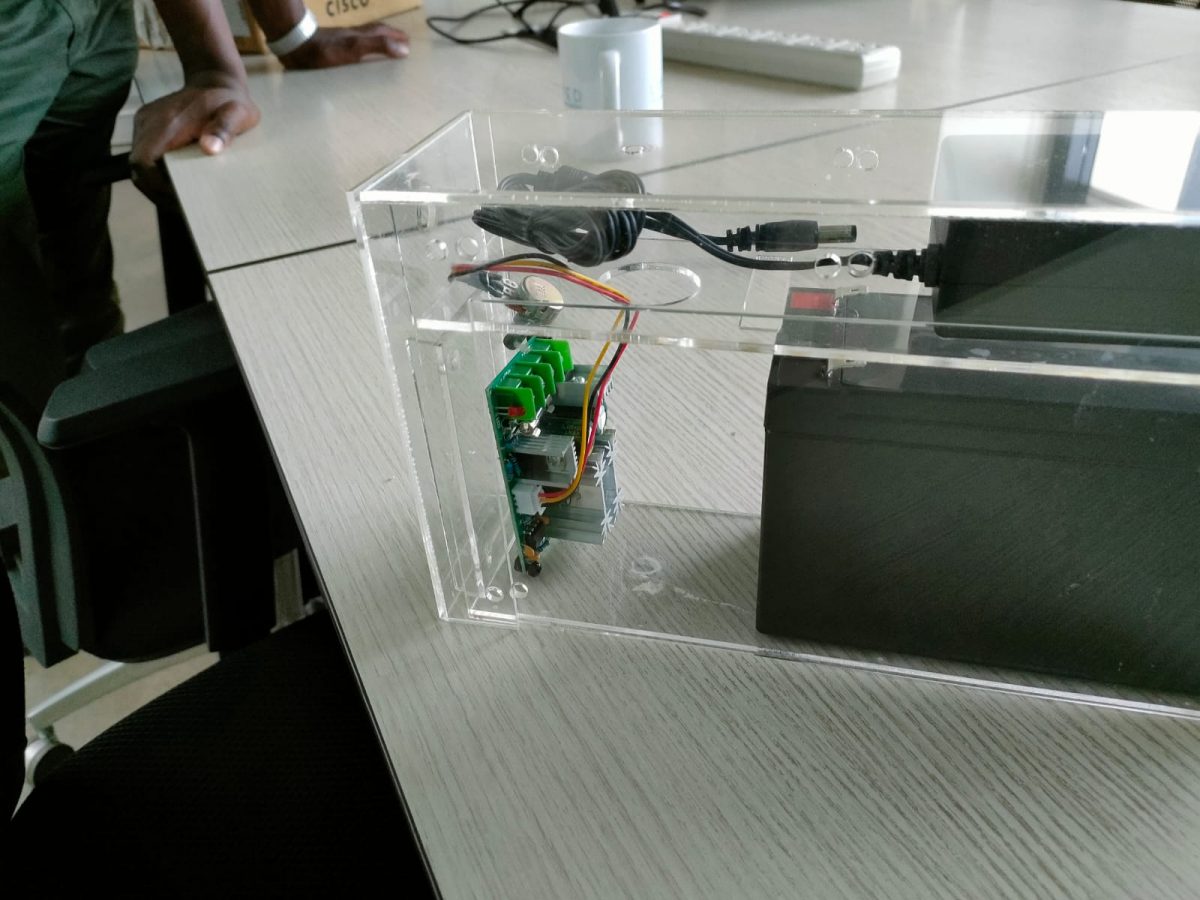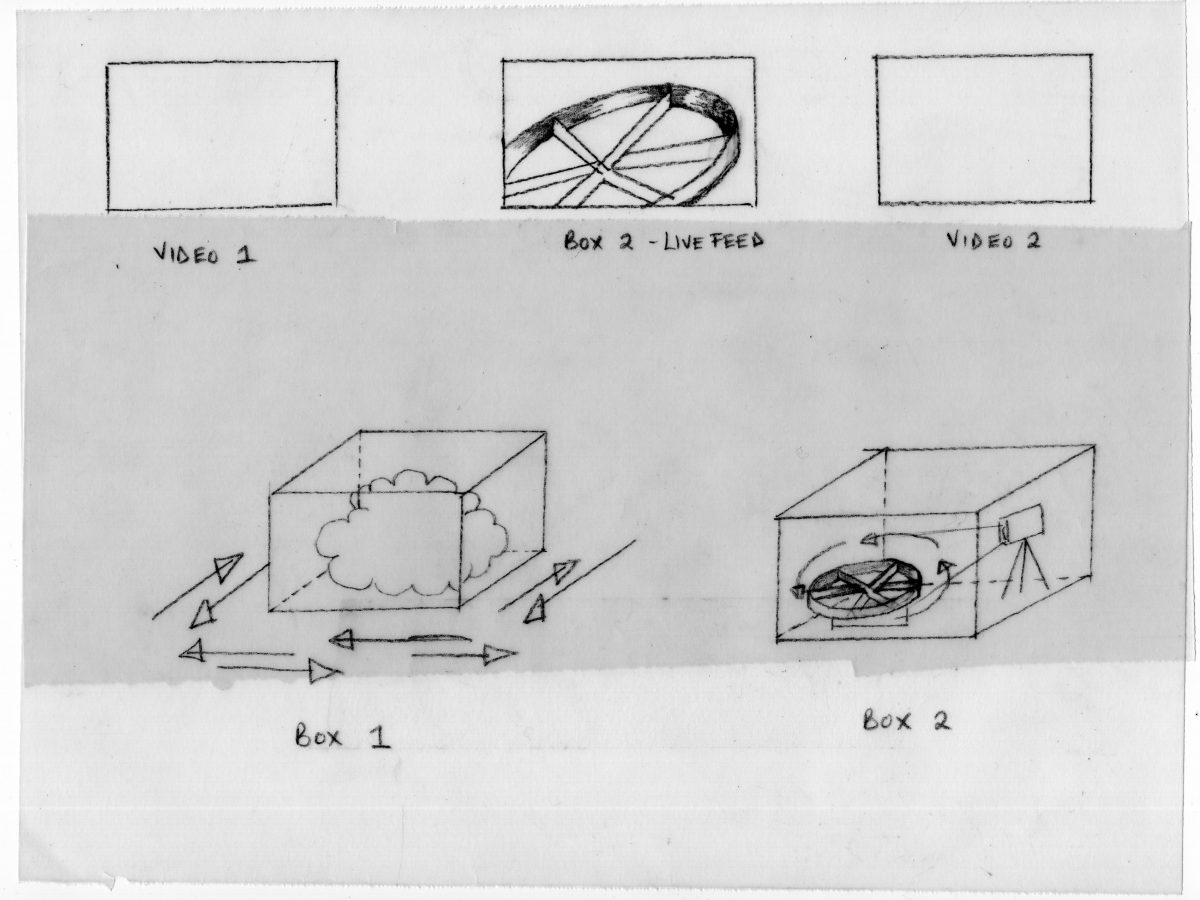How Clouds are Formed — a site-specific installation by Jackie Karuti
Published
For the symposium The Only Lasting Truth is Change, artist Jackie Karuti has developed a new weather instrument — a part of How Clouds are Formed (2019–), a developing body of work assembled in many parts and across different locations using objects, spare parts and movements. It is presented with video and a set of mechanical actions, where a motor converts electrical energy into mechanical energy. Please join us for the installation opening at aerial on Sunday 14 November at 14:00.
The installation, presented in Bergen, is assembled by artist Emilie Wright, following drawings, sketches, and instructions, produced by Karuti while developing another version of this weather instrument in Nairobi. For the opening event, BEK and aerial invite you to a conversation with Emilie Wright and artist Audrey Hurd, a resident of aerial, discussing the process behind building the instrument, as well as process oriented and social art practices.
The installation opening hours:
14 November 14:00–17:00
15–21 November 12:00–17:00 – note different opening hours for Saturday 20 November: 10:00-12:00
Address: aerial, C. Sundts gate 38, Bergen
On 20 November, Jackie Karuti will be speaking at the symposium about How Clouds Are Formed and reflect on the collective exploratory work of building weather instruments across Bergen, Nairobi and Berlin. More on Jackie Karuti´s live talk, Saturday 20 November
HOW CLOUDS ARE FORMED
How Clouds are Formed, site-specific installation, 2021
Electric motor, installed objects & video.
On display at Aerial 14–21 November 2021.
Jackie Karuti goes in search of a wind and gives form to this brief but repeated encounter experienced as a soft breeze that wafts through her every time she passes a particular bend on a road that leads towards Ngong Hills. She constructs an instrument that seeks to identify and measure this sensation and other phenomena caused by changing weather patterns, movement and shared intensities as part of her inquisition to her exploratory work, How Clouds are Formed.
How Clouds Are Formed (2019–) is a developing body of work assembled in many parts and across different locations using objects, spare parts and movements. It offers a reading of geographic and social climates through weather and whether instruments in correspondence with the Machine, Maps, Blueprints & Library Card as tools and collaborators. It has since become a method that offers multiple angles of entry into Karuti’s practice and a way to produce a site for something new to emerge.
This work is presented through video and a set of mechanical actions, where an electric motor converts electrical energy into mechanical energy. It’s an exercise in thinking about processes that occur outside of us and how we can intervene in their happening by observing, recording and measuring. It contemplates how certain movements and the things that move them, occur or are interrupted and the alternative ways we can think about them.
The installation, presented in Bergen, is assembled by Emilie Wright, following drawings, sketches, and instructions, produced by Karuti while developing another version of this weather instrument in Nairobi. The two versions are not identical. The artwork then becomes not the object but the (mechanical) action that performs a senseless/impossible task in a particular place.
Jackie Karuti
Jackie Karuti is an artist based in Nairobi, Kenya. Her practice employs the process of drawing, video and performance to generate thought. Her work is founded on ideas around knowledge production and accessibility as well as the depths of possibility enabled by radical imagination. Karuti is an alumnus of Àsìkò, a roaming Pan-African art school established by the late Bisi Silva, designed to redress the frequently outdated or non-existent artistic and curatorial curricula at tertiary institutions across Africa. Karuti was the 2020 recipient of the Henrike Grohs Art Award, which will see a publication of her work at the end of this year. She received the Follow Fluxus – After Fluxus 2021 grant for young contemporary artists, and her Follow Fluxus solo exhibition, Shapeshifting & the Impossibility of Weathered Wood, is open until 19 December 2021 at the Nassauischer Kunstverein, Wiesbaden, Germany. Other projects that respond to her practice include In The Case of Books, programming the Out Film Festival Nairobi and her online workspace I’ve been working on some MAGIC.
Emilie Wright
Emilie is an artist from Melbourne, Australia, currently living and working in Bergen, Norway. They work with a predominantly sound-based practice that is experimental and exploratory. Their work reflects upon technology and ecology from a posthumanist feminist perspective whilst working through notions of public, domestic and internal space in relation to gender, temporality and embodiment. Based upon the sonic encounter and notions of time and experience, their work takes the form of immersive sound installations, sound installations in public spaces and performances which are often articulated through text as a starting point.
aerial
aerial is an artist-run studio (and nap space) with a focus on social art practices. It was originally set-up by Stacy Brafield, William Kudahl and Gentian Meikleham in late 2019. Aerial is co-run by Stacy Brafield and Laurie Lax and is currently hosting Audrey Hurd, who will take part in the conversation at the exhibition opening 14 November. https://aerialbergen.org/
Audrey Hurd completed her Masters in Fine Art in Bergen in 2019. Her work focuses on touch as a means of understanding. She has co-produced workshops, events and publications as part of TEXSTgroup. www.audreyhurd.net
The Only Lasting Truth is Change
The Only Lasting Truth is Change is a durational symposium investigating future configurations of art, technology, nature and power. It is organised by BEK with support from Norsk kulturråd, Fritt Ord, Bergen kommune and KORO, and in cooperation with Ekko, Østre, aerial, Radio Multe 93.8 FM and KORO’s project STUDIO. Graphic design by Vera Gomes.
Image credits: Photos and installation sketch by Jackie Karuti.


